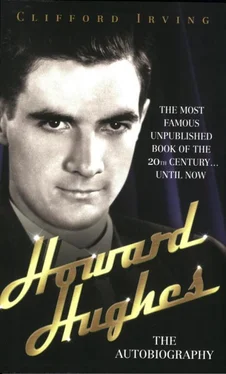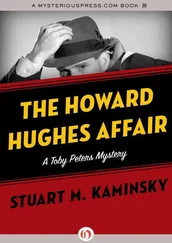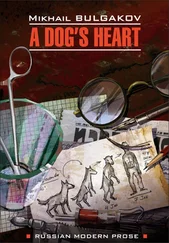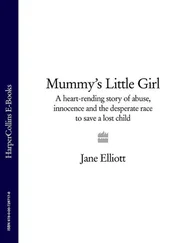Clifford Irving
HOWARD HUGHES
THE AUTOBIOGRAPHY
This book is dedicated, with love, to my sons
Josh, Nedsky, and Barnaby
THE BOOK YOU are now holding in your hands is one of the greatest untold stories of modern times. It reveals, for the first time, and in his own words, the full and unexpurgated life story of Howard Hughes, one of the most controversial and enigmatic figures of the 20th Century. Billionaire industrialist, daredevil aviator, film-maker and studio mogul, a womaniser who bedded some of the most beautiful women in Hollywood, by the late 1960s he had become known as the world’s richest and most bizarre recluse.
A truly extraordinary story then – all the more extraordinary for the fact that Howard Hughes never wrote his autobiography.
For what you are about to read is actually a hoax – a gloriously audacious, shameless and wildly entertaining scam, as bizarre in its own way as anything in the life of Hughes himself.
It was a hoax that shook the American publishing industry, captured headlines around the world, and led to its architect, Clifford Irving, serving time in prison. Irving was already a best-selling author when, in late 1970, he hit upon the idea of faking the autobiography of Howard Hughes – a man who had not been seen in public, or broken silence, for almost 15 years.
With forged letters Irving convinced his publishers that he had enlisted Hughes’ co-operation in the project. He received cheques made out to Hughes for around £750,000, which Irving’s wife Edith – carefully disguised in wig and dark glasses, with walnuts stuffed in her cheeks – deposited in a Swiss bank account. When suspicions began to grow, Irving’s forged letters were deemed as genuine by the world’s leading experts. But, at last, he confessed, and went to jail for two years – a seemingly harsh sentence for what had started out as a harmless caper. ‘I never thought I didn’t deserve to be there,’ Irving says now. ‘I remember one guy coming up to me one day in the yard and saying, “You know, Clifford, it’s wonderful to talk to you, because you and I are the only two guys in this place who admit to being guilty.”’
* * *
Clifford Irving now lives in Aspen, Colorado and on the Pacific coast of Mexico, where he spends his days writing and painting. Think Aspen, and you think millionaires and celebrities; but Irving is far from being a millionaire, and one senses that such celebrity as he has enjoyed in his life has been a mixed blessing. For a short while, he says, the notoriety was ‘an ego-kick.’ But the publishing industry took a long time to forgive him. For years he was unable to get his books in print; and while he went on to write a dozen more books, including four New York Times best-sellers, what irks Irving most deeply is that it is probably the hoax for which he will always be best known.
Born in 1930 and raised in Manhattan, the only child of a cartoonist, Irving published his first novel, On A Darkling Plain , when he was 26; it was written after hours in the offices of the New York Times where he was working as a copy boy. He went on to write many more novels, as well as non-fiction books about the Six Day War and the history of espionage. Restless by nature, he travelled throughout Mexico and Europe. By the early ‘60s he had settled on the island of Ibiza. ‘Cherchez la femme’ had been a prominent theme in his life, and by then he was already onto his third marriage. ‘I was brought up to be in love’, he says. ‘If you met a girl and you wanted her sexually, you had to believe that you loved her, because in my generation that was the only morally acceptable way of going forward.’ And so, in 1965 he married for the fourth time, to a Swiss painter named Edith Sommer, with whom he had two sons.
Ibiza in the ‘60s was a playground for artists, writers, bohemians and lotus eaters. ‘A wild place,’ Irving recalls, ‘where the watchword was “anything goes”.’ Among the more colourful members of the expatriate community was Elmyr de Hory, a Hungarian who rejoiced in the dubious reputation of being the most successful art forger in the world. Irving and de Hory became friends, and in 1969 Irving wrote a biography of de Hory’s life. The book, Fake! , ended their friendship, since de Hory objected to the way Irving had described him as ‘a charming crook’ – but it would lead indirectly to Irving’s plan to fake an autobiography of Howard Hughes.
In December 1970, Irving happened upon a Newsweek magazine article about Hughes, ‘The Case of the Invisible Billionaire’, describing how Hughes had recently decamped from his 9th floor redoubt in the Desert Inn Hotel, Las Vegas, to a new hotel hideout on Paradise Island in the Bahamas.
Irving was struck by a brainwave. He would fake an ‘authorised’ biography of Hughes. At last! The world’s most enigmatic man unveiled! It would be the story of the century. The reclusive Hughes, Irving reasoned, would never come forward to repudiate the book.
Irving enlisted a writer friend, Dick Suskind, to research the hard detail of Hughes’ life. To convince his publisher, McGraw-Hill, of authenticity, he forged a series of letters ostensibly from Hughes, and modelled on a fragment of handwriting which had appeared in the Newsweek article. In it, the billionaire (a neat touch, this) expressed his admiration for Irving’s book on the forger Elmyr de Hory, and suggested that he would be willing to co-operate with Irving on a book about his own life. ‘Hughes’ wrote that he did not want to die ‘without having certain misconceptions cleared up, and without having stated the truth about my life.’ But the project must remain secret, and he would deal only with Irving in any transactions, including financial ones.
It was never really about the money. Life was good. Irving – just turned forty – had a three-book contract; owned a lovely 15-room Ibizan farmhouse, and his own yacht. What he was in search of was adventure.
He negotiated a deal with McGraw-Hill in which ‘Hughes’ was to receive some $675,000 and Irving himself $100,000. How to bank the cheques? Irving told his publishers that Hughes wanted them made out to ‘H.R. Hughes’. Irving’s wife Edith – a willing co-conspirator – flew to Switzerland and opened an account in the name of Helga R. Hughes into which ‘Howard’s’ share of the money could be paid. Over the next nine months Edith would make several visits to Geneva, withdraw the money in cash and carry it back to Ibiza, where Irving secreted it atop various beams in their farmhouse.
Naively, he claims, he didn’t grasp that they were committing a crime. ‘We thought: They can’t put you in jail for committing a hoax, can they? Especially if you have the money set aside to return, as indeed we did. It just seemed like such an elegant scheme from which I could withdraw at any time I wanted.’ That, he acknowledges with a rueful smile, was ‘the great fallacy’.
Irving told McGraw-Hill that the book would be based on a series of interviews which he was to conduct with Hughes under conditions of the utmost secrecy. To avoid any untoward leaks Irving and his publishers came up with a codename, ‘Project Octavio’, to use in their discussions about Hughes. The author then constructed an elaborate itinerary, travelling to Mexico, Puerto Rico and the Bahamas, reporting back after each trip with ever more fanciful accounts of his clandestine (and completely fictional) meetings with his subject.
Читать дальше













